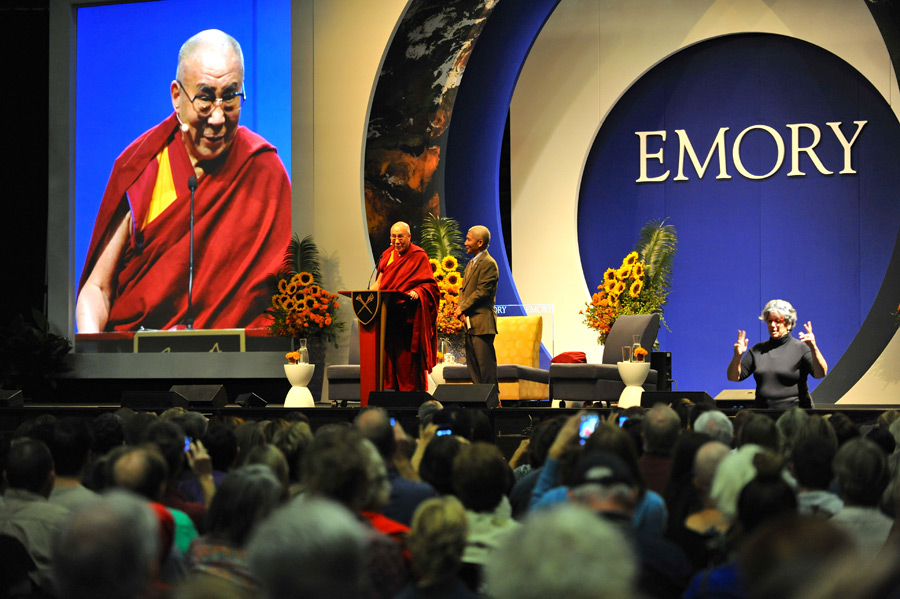Students attend Dalai Lama’s lecture on secular ethics

Photo Courtesy of Dalailama.com
On Oct. 8, 14 Maryville College students and three professors flocked into the crowded Gwinnet Arena in Atlanta along with thousands of fortunate spectators to witness a lecture delivered by His Holiness the 14th Dalai Lama Tenzin Gyatso.
The position of the Dalai Lama can be described in short as the spiritual and, formally, the political leader of Tibet. Within the Buddhist faith, the Dalai Lama is believed to be the manifestation of Chenrezig, the Bodhisattva of Compassion and is similar to a patron saint of Tibet. A Bodhisattva is an enlightened being who has postponed attainment of nirvana and follows a cycle of rebirth in order to serve humanity. His Holiness Tenzin Gyatso is believed to be a direct reincarnation of the 13 previous Dalai Lamas as well as 74 in a lineage that can be traced back to a Brahmin boy who lived at the time of Buddha Shakyamuni, whose teaching formed the foundation of Buddhism. However, it is not simply his spiritual importance that makes His Holiness’s visit so monumental. In fact, in a worldly sense, the importance of the Dalai Lama probably lies more with his humanity than with his divinity.
Junior Tyler Jones described the Dalai Lama’s physical appearance as many would expect: 78-years-old, bald, with large glasses and the traditional robes of maroon and gold. However, what one lacks in this description is the incredible magnitude of both his presence and his humility.
“Something that was really remarkable was the sincerity that His Holiness exuded,” Jones said.
He described the Dalai Lama as both humble and hilarious, wearing a plastic visor to protect his eyes from the lights and telling stories about a blind friend whom he always joked had the misfortune of being unable to see how beautiful his own wife and children were. This genial, unassuming humor was reminiscent of the stereotypical venerable grandfather.
However, the Dalai Lama’s life has been marred with conflict. Early in his time as spiritual leader of Tibet, the Tibetan nation was invaded and oppressed by China. Following several acts of violence against the Tibetan nation and the imprisonment of many of Tibet’s people, the Dalai Lama himself was forced to flee his country as a refugee. In his lecture, he described his generation as one marked by conflict and violence, and charged the new generation with the task of replacing this violence with acceptance and peace.
More remarkable perhaps than his situation is the fact that, despite exile and upheaval, despite attacks on his people and their way of life, the Dalai Lama still firmly believes in nonviolence. Rather than answering hatred with more hatred, His Holiness follows an intrinsic belief in morality and compassion.
The over arching theme of his lecture dealt with the role of morality in a globalized society. Essentially, the Dalai Lama believes that, at a fundamental level, all humans share the desire for happiness and fulfillment and, through this desire, share the basic capability to act with compassion. His lecture expounded on this basic capability not only from a spiritual standpoint, but from a scientific one. Speakers at the lecture included a neuroscientist whose experiments explored the moral recognition of infants and a primatologist whose studies had noted a basic understanding of fairness and reconciliation in primates. These researchers, in conjunction with the Dalai Lama, asserted that the concepts of kindness and equality are instinctual rather than learned and, therefore, inherent in all humanity.
From this stance, His Holiness emphasizes the importance of religious harmony between all groups, stating that “Despite philosophical differences, all major world religions have the same potential to create better human beings.” At the basis of all religion, His Holiness finds the common practices of tolerance, acceptance and compassion. Through the expansion and continued use of these traits, he believes human change is possible.
“His earnest, sincere disposition is a reflection of not only the Buddhist doctrines that surround his philosophies, but also a reflection of the tumultuous era in which he was raised,” Jones said.
